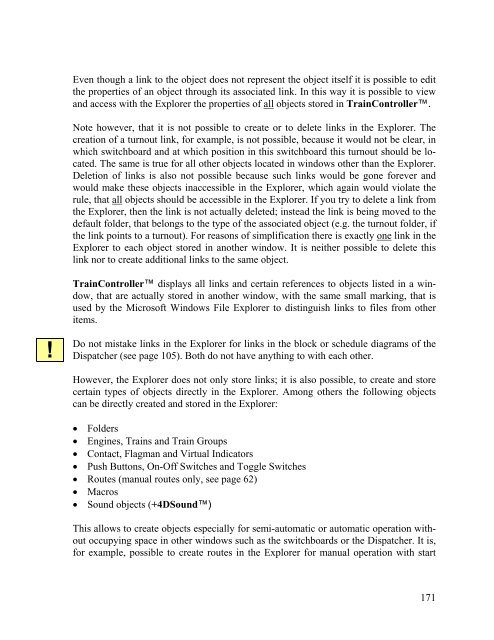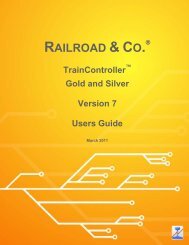Download - Freiwald Software
Download - Freiwald Software
Download - Freiwald Software
Create successful ePaper yourself
Turn your PDF publications into a flip-book with our unique Google optimized e-Paper software.
!<br />
Even though a link to the object does not represent the object itself it is possible to edit<br />
the properties of an object through its associated link. In this way it is possible to view<br />
and access with the Explorer the properties of all objects stored in TrainController.<br />
Note however, that it is not possible to create or to delete links in the Explorer. The<br />
creation of a turnout link, for example, is not possible, because it would not be clear, in<br />
which switchboard and at which position in this switchboard this turnout should be located.<br />
The same is true for all other objects located in windows other than the Explorer.<br />
Deletion of links is also not possible because such links would be gone forever and<br />
would make these objects inaccessible in the Explorer, which again would violate the<br />
rule, that all objects should be accessible in the Explorer. If you try to delete a link from<br />
the Explorer, then the link is not actually deleted; instead the link is being moved to the<br />
default folder, that belongs to the type of the associated object (e.g. the turnout folder, if<br />
the link points to a turnout). For reasons of simplification there is exactly one link in the<br />
Explorer to each object stored in another window. It is neither possible to delete this<br />
link nor to create additional links to the same object.<br />
TrainController displays all links and certain references to objects listed in a window,<br />
that are actually stored in another window, with the same small marking, that is<br />
used by the Microsoft Windows File Explorer to distinguish links to files from other<br />
items.<br />
Do not mistake links in the Explorer for links in the block or schedule diagrams of the<br />
Dispatcher (see page 105). Both do not have anything to with each other.<br />
However, the Explorer does not only store links; it is also possible, to create and store<br />
certain types of objects directly in the Explorer. Among others the following objects<br />
can be directly created and stored in the Explorer:<br />
• Folders<br />
• Engines, Trains and Train Groups<br />
• Contact, Flagman and Virtual Indicators<br />
• Push Buttons, On-Off Switches and Toggle Switches<br />
• Routes (manual routes only, see page 62)<br />
• Macros<br />
• Sound objects (+4DSound)<br />
This allows to create objects especially for semi-automatic or automatic operation without<br />
occupying space in other windows such as the switchboards or the Dispatcher. It is,<br />
for example, possible to create routes in the Explorer for manual operation with start<br />
171










